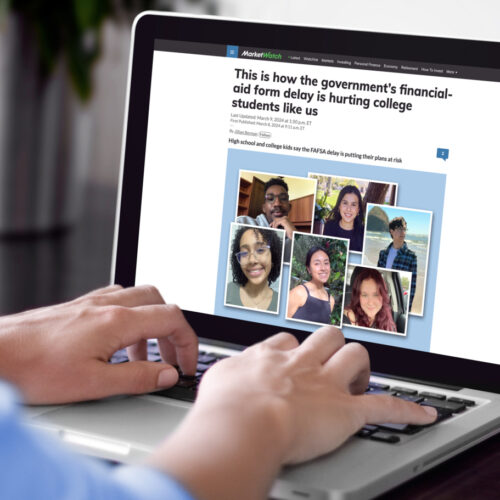In the 2016-2017 School year, PeerForward began exploring a novel intervention to one of higher education’s most pressing problems: student persistence. The numbers tell a grim story. According to the National Center for Education Statistics, among 2011-12 first-time beginning postsecondary students, nearly one out of every three had not earned a credential and were not enrolled in any institution as of Spring 2017. The concern grows when we focus specifically on students who first enrolled in public two-year institutions, where over the same period 46% of students had not earned a credential and were not enrolled in any institution. Interventions to get students to and through college, are abundant. And, while some have found success. the search continues for the right solution to address higher education’s most pressing problems.
“With a Little Text from My Friends”
Two methods that yield some promise for improving postsecondary outcomes have piqued the interest of educational researchers and practitioners over the last few years. Those two methods are peer influence and text-based interventions. While these and various other methods have yielded some individual success, addressing the lingering problem of persistence could require that two be combined to maximize effectiveness and scale. Could a text-based peer influence model be successful in guiding college students through college?
Many interventions rely on adults to guide students toward success. However, some evidence suggests that near peers are more influential than adults in the choices that youth make. A 2006 Study, in fact, found that that having friends who plan to go to college and who also wish the same for their friends is the single best predictor of 4‐year college enrollment for low‐income minority students. PeerForward has built a successful program around the influence of peers. The program is based on the theory of change that a team of trained, influential high school students can harness the power of positive peer influence to lead more students to enroll in college. PeerForward has demonstrated the effectiveness of its program in high school, solving a portion of the college access problem. The program and other stakeholders in education have become interested in understanding whether the peer influence model could have similar effectiveness for the problem of college persistence.
Cost and scale are two of the biggest challenges to implementing programs like PeerForward on college campus. However, one potentially promising answer to the cost-and-scale challenge in postsecondary institutions is to harness the power of technology through texting. Research has suggested that generic texting campaigns can lead to improved college outcomes through what has come to be known as text “nudges.” With the right timing and cadence, texts messages give otherwise unconnected first-year college students the information and encouragement they need to navigate their new postsecondary environments. PeerForward endeavored to explore whether the power of texts messages could be combined the power of peers to eliminate the persistence problem.
First Year Forward Evaluation
Building on evidence of its own peer influence-based model and the promise of text messaging, the First Year Forward model involves having college-bound Peer Leaders – students who, through PeerForward’s high school program, have been trained to motivate their fellow high school students – send text communication to incoming freshman at universities across the country. University of Virginia researchers conducted a rigorous evaluation of PeerForward’s First Year Forward program across three cohorts (Fall 2017, 2018, and 2019 enrolling students). Due to some programmatic changes following the first year of the program’s implementation, researchers focused on 2017 and 2018 enrolling students. Across both cohorts, the evaluation suggested students participating in the First Year Forward program did not experience any persistence benefits when compared to similar students in a control group. The results suggest that PeerForward model of peer influence cannot be applied solely though text messaging.
The Way Forward
All is not lost. The promise of text messaging has shifted since the inception of the First Year Forward program. At one point, generic texts were thought to be enough to “nudge” students to take the right steps in the college journey to get them through their first year of college. Some of the biggest proponents of text messaging for solving college success challenges have since conducted research suggesting students often do not find one‐way texts highly valuable and will begin to disengage. The field has even shifted from two-way text messages, with more evidence suggesting instead that AI-based chat bots offer the greatest benefit students. These chatbots not only provide timely nudges but can also provide instant answers, personalized to students’ status and needs.
There’s no doubt that AI-based chat bots can provide students with information that even the most knowledgeable peer may not be able to provide (e.g. missing financial aid documents, missing required courses, etc.). But research continues to show campus engagement is one of the keys to persistence; and chat bots can’t create a sense of community another known mechanism for postsecondary success. It’s likely that technology and peer influence will need to combine forces to help more students achieve what they set out to do when they step foot on their various college campuses.
Based on findings from First-Year Forward, PeerForward now is in its second year of bringing an evolved version of peer leadership to colleges. Early results are promising. Colleges can build capacity quickly to provide wrap-around support to students by tapping and training influential students who will text, but also coach one-to-one and organize group events for select students identified by their institution as at-risk. College Peer Leaders are paid through Work Study, AmeriCorps, and similar programs.
The college persistence problem is pervasive, and the need has never been greater in the wake of the double-digit pandemic drops in enrollment. Yet the power of peers in college remains systematically untapped. PeerForward in College is making the mold for how to leverage a readily available resource to produce better outcomes – influential students.
PeerForward is grateful to the Michael & Susan Dell Foundation for supporting First Year Forward.











